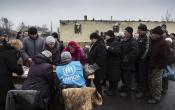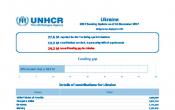Ukraine Regional Office
For information on UNHCR’s operations in Ukraine from 2016 onwards, please visit the Ukraine country page.
Operation: Ukraine Regional Office
Location
{"longitude":31,"latitude":49,"zoom_level":5}
Latest update of camps and office locations 21 Nov 2016. By clicking on the icons on the map, additional information is displayed.
Key Figures
| 2015 end-year results | |
| 372 | trucks with shelter materials and non-food items were sent to government-controlled (250 trucks) and non-government controlled (122 trucks) areas |
| 1.75 | million beneficiaries received winterisation assistance including accommodation upgrade, firewood or coal, and cash grants |
| 208,362 | IDPs received legal assistance |
| 29,872 | IDPs benefited from shelter support |
| 1,342 | people were assisted to address specific pressing protection needs such as acute medical condition, threat of eviction, etc. |
Latest Updates and Related Links
People of Concern
89%
Increase in
2015
2015
| 2015 | 1,658,297 |
| 2014 | 877,606 |

[]
Loading ...
Ukraine Regional Office
< Back
2016
{"categories":[2013,2014,2015,2016,2017,2018],"budget":[11.72227578,22.32909902,50.666041663,null,null,null],"expenditure":[7.26738195,14.61218829,28.43463568,null,null,null]}
{"categories":[2013,2014,2015,2016,2017,2018],"p1":[10.40727575,10.2555022,12.333912034,null,null,null],"p2":[1.31500003,1.48059682,1.010000629,null,null,null],"p3":[null,null,null,null,null,null],"p4":[null,10.593,37.322129,null,null,null]}
{"categories":[2013,2014,2015,2016,2017,2018],"p1":[6.96856879,6.37637522,4.37618785,null,null,null],"p2":[0.29881316,0.2656573,0.10732777,null,null,null],"p3":[null,null,null,null,null,null],"p4":[null,7.97015577,23.95112006,null,null,null]}
Loading ...
CHOOSE A YEAR
- 2014
- 2015
Working environment
- By year-end, the overall security situation in Ukraine remained relatively calm, which allowed UNHCR to deliver assistance to the most needy internally displaced people (IDPs) and affected populations along the contact line dividing government and non-government controlled areas and, to a certain extent, in the non-government controlled areas in the east of the country.
- UNHCR’s response to internal displacement, on the basis of the 2015 Humanitarian Response Plan (HRP), focused on three main objectives: i) respond to the protection needs of displaced and other conflict-affected people; ii) provide life-saving assistance and ensure non-discriminatory access to quality essential services; and iii) improve the access of displaced and conflict-affected people to high-impact early recovery activities with a focus on livelihoods opportunities, normalization of basic services.
- UNHCR continued to lead the Shelter/NFI Cluster and co-lead the Protection Cluster (with OHCHR).
- Several important legislative initiatives were made relating to asylum issues, such as the inclusion of social welfare and local integration for refugees in the National Human Rights Strategy and its Action Plan; the improvement of the RSD process; and documentation of asylum-seekers (provision of temporary documentation, support with translation, written notification of the decision, among others).
Population trends
- The number of IDPs officially registered by the Government reached 1.7 million. The UN adopted an estimate of 800,000 IDPs for planning purposes.
- The total number of Ukrainians seeking asylum or other forms of legal stay in neighbouring countries since the beginning of the crisis reached more than 1.1 million.
- At the end of 2015, Ukraine hosted 3,273 refugees and 6,502 asylum-seekers. The majority of refugees and asylum-seekers originate from Afghanistan and Syria; some 70 other countries of origin are also represented.
- Over 35,000 people were estimated to be stateless.
Achievements and impact
- As co-lead of the Protection Cluster, UNHCR supported the network of NGO legal service providers to ensure access to primary legal counselling and effectively reach IDPs, in particular vulnerable groups.
- Advocacy at the national level contributed to the adoption of Law No. 2166, which brought the IDP legislation in line with the Guiding Principles on Internal Displacement. The Government approved the Comprehensive State Programme for Support, Social Adaptation, and Reintegration of Internally Displaced Persons for a period until 2017.
- As part of the Shelter/NFI Cluster’s interventions, UNHCR provided shelter and infrastructure assistance to individual households by repairing damaged residential property, with a completion rate of some 55 per cent by the end of the year.
- UNHCR invested in building the capacity of relevant stakeholders to proactively identify SGBV incidents, and supported several local projects aimed at raising awareness and defining referral pathways. Some 160 known survivors were assisted.
Unmet needs
- UNHCR faced restrictions on humanitarian access in non-government controlled areas, which impacted on the delivery of assistance. Although relative progress was made to improve humanitarian access in Luhansk, the restriction in non-government controlled areas of Donetsk remained unchanged.
- UNHCR carried out a series of participatory assessments among IDPs, which found that the most urgent needs were linked to accommodation, employment, access to education.
- The potential for local integration of refugees remained significantly limited due to the lack of capacity and financial resources.
Plan Overview



